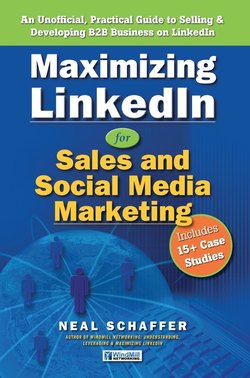Читать книгу Maximizing LinkedIn for Sales and Social Media Marketing: An Unofficial, Practical Guide to Selling & Developing B2B Business On LinkedIn - Neal Schaffer - Страница 4
На сайте Литреса книга снята с продажи.
Introduction
ОглавлениеAs you look at the title of this book, you may wonder how one book could combine two distinctly different corporate disciplines.
It is true that, regardless of the company, people who work in sales and marketing are often separated into different departments, but it is their combined efforts and achievements that allow a company to become and stay profitable. Professionals in these two areas of business are essential in generating leads, developing prospective business, and closing deals, while small-business owners and entrepreneurs often have to take on both of these roles simultaneously.
With social customer relationship management (CRM) software, everybody in the company can gain access to the social media conversations of both present customers and decision makers for deals in the pipeline, and it is more important than ever that these two departments, which are responsible for a given company’s revenue, work closely together. I have been responsible for the profit and loss for many organizations, and whenever the sales and marketing teams were in synch, everybody won, including our customers. Writing a book that can be used by both groups is a natural progression of social business.
Social media further blurs the line between sales and marketing because potential customers or new leads can interact with a social media profile that simply identifies a corporation rather than a single person in a particular department. Similarly, LinkedIn was not built for a specific discipline but is built on a unique platform that can accommodate business professionals who have a narrow work focus as well as those who work in many different capacities. For example, someone working in sales may find it worthwhile to use LinkedIn for gathering business intelligence and making contact with leads that are passed to them by the marketing department, while those in marketing might concentrate their efforts on generating discussions and leads in industry-specific LinkedIn Groups. Professionals representing small businesses or start-ups, or entrepreneurs who run businesses with extremely limited staff, may be using LinkedIn in a search for influential business partners who can help get them to the next level. Due to the interrelated nature of sales and marketing, it is important to understand how these two main outward-facing functions of a company can guide interactions on LinkedIn in a way that promotes the work of both the sales and marketing departments as well as the overarching mission of a particular company.
Though you’ll interact as an individual with others on LinkedIn, there is an opportunity for your company to be represented on the site as well. In addition to addressing how to establish your personal credibility as a sales or business development professional on the site, this book provides information on how to establish a corporate marketing presence on LinkedIn (such as in Chapter 5 regarding companies pages and in Chapter 6 regarding groups). It’s important to consider this hybrid approach because LinkedIn was originally created for professional networking by individuals, but there is an obvious advantage for companies that have both a corporate presence and an active employee presence on LinkedIn. Business is a fluid concept, and because so many positions require some crossover between sales and marketing—and because companies have a stake in having both departments represented online—it simply makes sense to address them both under the same cover.
I highly recommend that everyone read all sections of this book to better understand all aspects of the sales, marketing, and business development spectrum on LinkedIn. However, because this book addresses individual profiles as well as the corporate presence of enterprises, you may focus on those chapters that are most appropriate to your specific professional role in your company as follows, although all of the content will be relevant to small-business owners and solo practitioners:
•Chapters 1 and 2—Background information on the importance of social media in general, and LinkedIn specifically, for professionals [everyone]
•Chapters 3 and 4—Optimizing profiles and networks for individuals [everyone]
•Chapters 5 and 6—Establishing your company’s LinkedIn Group and Companies Pages [corporate marketing]
•Chapters 7, 8, and 9—Developing business by engaging, prospecting, and utilizing business intelligence available on LinkedIn [sales and business development]
•Chapters 10, 11, and 12—Using LinkedIn to develop leads and attain thought leadership through participation, paid media, and social media optimization [corporate marketing]
•Chapters 13 and 14—Optimizing the LinkedIn presence through optional paid accounts and creating a daily routine for maximum efficiency and return on investment (ROI) [everyone]
If you are interested in learning more about LinkedIn and social media after reading this book, take a look at Appendix A, which provides additional online and print resources of interest. Case studies throughout the book and cataloged in Appendix B illustrate how professionals and corporations have used LinkedIn successfully, and will I hope provide inspiration for you and your employees, regardless of specific job functions.
The content presented in this book, along with this supplemental material, will equip the sales, marketing, and business development professionals at your company with new and creative ways to develop and foster business so that everyone can enjoy the success of maximizing LinkedIn.
1
